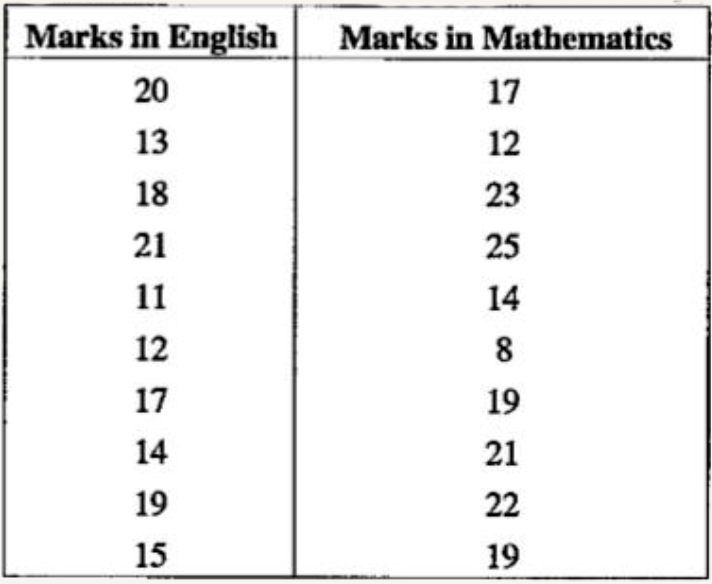The adjoining pie chart gives the marks scored in an examination by a student in Hindi, English, Mathematics, Social Science and Science. If the total marks obtained by the students were 540, answer the following questions.(i) In which subject did the student score 105 marks?(Hint: for 540 marks, the central angle = 360°. So, for 105 marks, what is the central angle?)(ii) How many more marks were obtained by the student in Mathematics than in Hindi?(iii) Examine whether the sum of the marks obtained in Social Science and Mathematics is more than that in Science and Hindi (Hint: Just study the central angles).
To solve the problem step by step, we will address each part of the question systematically.
Given Information:
- Total marks obtained by the student = 540
- Subjects: Hindi, English, Mathematics, Social Science, Science
(i) In which subject did the student score 105 marks?
1. Calculate the central angle for 1 mark:
Central angle for 1 mark=360°540=23° (per mark)
2. Calculate the central angle for 105 marks:
Central angle for 105 marks=360°540×105=23°×105=70°
3. Identify the subject with a central angle of 70°:
- The subject corresponding to 70° is Hindi.
Answer: The student scored 105 marks in Hindi.
(ii) How many more marks were obtained by the student in Mathematics than in Hindi?
1. Identify the central angle for Mathematics:
- From the pie chart, Mathematics corresponds to a central angle of 90°.
2. Calculate the marks for Mathematics:
Marks in Mathematics=360°540×90=23°×90=135
3. Calculate the difference in marks between Mathematics and Hindi:
Difference=Marks in Mathematics−Marks in Hindi=135−105=30
Answer: The student obtained 30 more marks in Mathematics than in Hindi.
(iii) Examine whether the sum of the marks obtained in Social Science and Mathematics is more than that in Science and Hindi.
1. Identify the central angles for Social Science and Science:
- Social Science corresponds to a central angle of 65°.
- Science corresponds to a central angle of 80°.
2. Calculate the marks for Social Science:
Marks in Social Science=360°540×65=23°×65=97.5
3. Calculate the marks for Science:
Marks in Science=360°540×80=23°×80=120
4. Calculate the total marks for Social Science and Mathematics:
Total for Social Science and Mathematics=97.5+135=232.5
5. Calculate the total marks for Science and Hindi:
Total for Science and Hindi=120+105=225
6. Compare the two totals:
232.5>225
Therefore, the sum of the marks obtained in Social Science and Mathematics is more than that in Science and Hindi.
Answer: The sum of the marks obtained in Social Science and Mathematics is more than that in Science and Hindi.
- Total marks obtained by the student = 540
- Subjects: Hindi, English, Mathematics, Social Science, Science
Central angle for 1 mark=360°540=23° (per mark)
Central angle for 105 marks=360°540×105=23°×105=70°
- The subject corresponding to 70° is Hindi.
- From the pie chart, Mathematics corresponds to a central angle of 90°.
Marks in Mathematics=360°540×90=23°×90=135
Difference=Marks in Mathematics−Marks in Hindi=135−105=30
- Social Science corresponds to a central angle of 65°.
- Science corresponds to a central angle of 80°.
Marks in Social Science=360°540×65=23°×65=97.5
Marks in Science=360°540×80=23°×80=120
Total for Social Science and Mathematics=97.5+135=232.5
Total for Science and Hindi=120+105=225
232.5>225
Therefore, the sum of the marks obtained in Social Science and Mathematics is more than that in Science and Hindi.
Topper's Solved these Questions
- DATA HANDLINGBOOK - NCERT ENGLISHCHAPTER - DATA HANDLINGEXERCISE - SOLVED EXAMPLES
1 Videos
- DATA HANDLINGBOOK - NCERT ENGLISHCHAPTER - DATA HANDLINGEXERCISE - EXERCISE 5.1
5 Videos
- CUBES AND CUBE ROOTSBOOK - NCERT ENGLISHCHAPTER - CUBES AND CUBE ROOTSEXERCISE - SOLVED EXAMPLES
8 Videos
- DIRECT AND INVERSE PROPORTIONSBOOK - NCERT ENGLISHCHAPTER - DIRECT AND INVERSE PROPORTIONSEXERCISE - EXERCISE 13.1
10 Videos
Similar Questions
The following pie-chart gives the marks scored in an examination by a student in various subjects. If the total marks obtained by the student were 540, answer the following questions.
View SolutionThe table shows the marks obtained by 25 students in a class test. Find the mean of the marks obtained

View SolutionThere are 60 students in a class. The followng is the frequency distribution of marks obtained by the students in a test.

where x is positive integer. Determine the mean of the marks.
View SolutionThe marks distribution of 30 students m a mathematics examination are given in Table of Example 1. Find the mode of this data.
View SolutionAnjali scores 100 marks in Mathematics and x marks in Science. what is her total score in Science and Mathematics?
View SolutionIn Figure, the pie-chart shows the marks obtained by a student in an examination. If the student secures 440 marks in all, calculate his marks in each of the given subjects.
View SolutionThe marks obtained by 10 candidates in English and Mathematics are given below:

Estimate the probable score for Mathematics if the marks obtained in English are 24.
View SolutionThe marks obtained (out of 30) by five students in a test are 20, 15, 25, 18, and 22. Find the average marks obtained.
View SolutionIf for somex∈R, the frequency distribution of the marks obtained by 20 students in a test is:

Then the mean of the marks is:
View SolutionThe marks of 8 students in an examination in Statistics and Mathematics are given below

Find Spearman's rank Correlation coefficient.
View Solution
